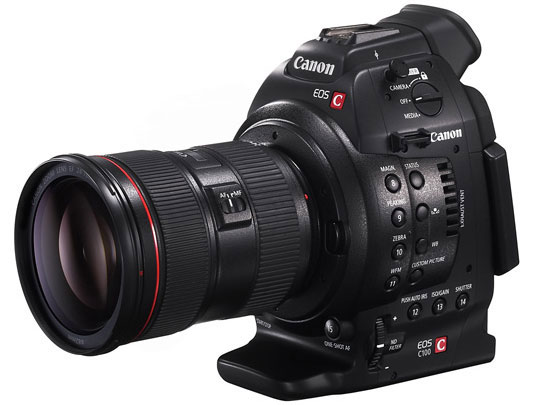It was a well expected and speculated about camera, Canon’s rumored interchangeable-lens digital cinema camera. Now the Canon EOS C100, the entry-level model in Canon’s Cinema EOS System offering high resolution, is official. With the advancement of social media and online reporting, videography is more and more important, but which Indie filmmaker or videographer is able to afford one of the camera beasts? Such as the newly announced hefty C500, priced at $30k…? Well, here comes the relatively affordable C100.

Best of it, you can mount your prime L glass. Here’s a 35mm 16:9 full-frame CMOS sensor with Full HD capture and ISO range of 320 to 20,000 sporting the EF mount system. The compact CD100 (key features) cannot mount PL lenses. Still, sounds like not only the aspiring videographer’s wish come true. No more complicated setups having to use your full-frame DSLR to shoot footage with creamy bokeh and amazing depth of field. The C100 with 1,920 x 1,080 AVCHD essentially offers a new prospect for those with pockets not quite so deep.
It’s a street photographer’s “low budget” video cam; a “baby C300,” 15% smaller than the advanced C300, but it shares a surprising amount with its big brother. Other features of interest include a push auto iris function, one-shot auto focus, a multi-angle 3.5-inch LCD and a locking HDMI output. All this available in November for tax-deductible $7,999, a bargain in cinema camera terms.
Along with it the C100 Canon offers two new cinema lenses: the CN-E15.5-47mm T2.8 L S/SP wide-angle and the CN-E30-105mm T2.8 L S/SP telephoto. All the lens details in this press release.
All that glitters is not gold. However, the Net’s initial feedback is quite positive.
Says Vincent Laforet:
If this camera is available in the $6-7K range on the street one day — it could really question the need to shoot on HDSLRs anymore (that is for those buying the 5DMKIII or 1D X — as those cameras invariably lead to the purchase of EVFs, LCDs, cages, matte boxes and ND… That doesn’t of course mean the end of HDSLRs for those of course who (like most people) are trying to look for a more affordable entry point, such as the 60D, 7D or Rebel of course. But for Indie filmmakers or productions — HDSLRs are now perhaps going to seem a lot less attractive.
NoFilmSchool says Canon missed a perfect opportunity:
Canon missed a perfect opportunity to introduce this camera at the same price point as the FS100, except with ND filters. They also missed out on putting their mirrorless mount on this camera. Maybe this is because Canon understands many people don’t want to deal with adapters, but Sony’s cameras have been extremely popular at the lower end specifically because of the ability to adapt almost any lens imaginable.
There’s no question this camera will fly off the shelves just like the C300 did, but when I can get RAW and ProRes/DNxHD for $3,000, is paying another $5,000 for ND filters, a bigger sensor, and a little more light sensitivity really that enticing? At least not for me personally, but I’m sure this camera will perform admirably since it probably shares a similar, if not the same sensor as the C300.
I think this will be a very successful camera and I feel Canon have partially made up for the recent disappointments sub $15,000, hell even sub $4,000. Although $8,000 is still out of the hands of the masses, many more working pros will find a way to justify the investment than before and what Canon chose to cut out (the better MPEG codec, bolt on screen, HD-SDI) pales into significance compared to what they kept.
Many of us cannot afford an $8,000 camera. Which is why the HDSLR line has made such an impact on filmmakers in the first place — it’s low-cost! While I agree this is the lowest price of the EOS line, many will quibble with the idea that this is priced for the beginning filmmaker. It very well could be a great price for some wedding filmmakers or schools that are looking to have low-priced cameras for their students. But then again, the HDSLRs are also in that category (…)
This is also the first camera we’ve seen that can record to both SD cards simultaneously (optional) giving you an instant backup if the first card has a problem. B&H also reports in their “in-depth” page: “The camera also supports HD to SD down-converting for creating files that are the optimal size for DVD and Web uploads” — I’m not quite sure why Canon has put this into the camera, isn’t this something that you can do after the fact to create MPEG-2? Why would you want to do it in camera?
Also curious Canon isn’t adding 60 frames per second in 1080 output – heck, this camera doesn’t even do 60 fps in a lower resolution.
CNET‘s Lori Grunin:
Canon’s targeting traditional video users with the C100: according to the press release, it’s going after “low-budget television production and independent moviemaking; museums, galleries and film schools that utilize Full HD video; and wedding, corporate and event videography.” For those shooters, the workaday benefits of the reasonably sized files and workflow-standard codecs will likely outweigh the longing for the better tonal range provided by deeper color subsampling and sharper image from a higher-resolution capture. That said, Sony’s rumored full-frame interchangeable-lens camcorder sounds like it’s supposed to come in at a lot lower price.


